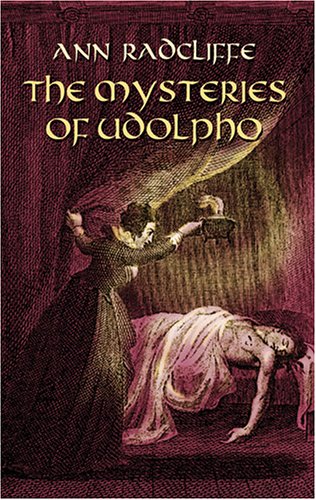John Percy’s Compositions Based on Lyrics by Ann Radcliffe
Contributed by Mandy Swann
 Ann Radcliffe’s poems were more popular than has previously been recognised. John Percy, an English tenor, organist and composer set five of Radcliffe’s poems to music . Percy’s ballads were popular in the eighteenth-century. Based on plays and novels, Percy’s compositions tapped into the emerging English middle class market. All of the poems by Radcliffe that Percy set to music (1795-7) are from The Mysteries of Udolpho (1794): “The Sea Nymph”, “Air”, “The Last Hour of Evening”, “The Shipwreck” and “The Pilgrim”. John Percy’s compositions have not been re-published since the eighteenth-century. Recordings of two of these compositions, “The Sea Nymph” and “Air” are made available as the result of ongoing research conducted by Mandy Swann (at UNSW, Australia). The recordings feature Phoebe Humphries, Soprano, Lloyd Grant, Piano, and David Gilfillan as Sound Engineer.
Ann Radcliffe’s poems were more popular than has previously been recognised. John Percy, an English tenor, organist and composer set five of Radcliffe’s poems to music . Percy’s ballads were popular in the eighteenth-century. Based on plays and novels, Percy’s compositions tapped into the emerging English middle class market. All of the poems by Radcliffe that Percy set to music (1795-7) are from The Mysteries of Udolpho (1794): “The Sea Nymph”, “Air”, “The Last Hour of Evening”, “The Shipwreck” and “The Pilgrim”. John Percy’s compositions have not been re-published since the eighteenth-century. Recordings of two of these compositions, “The Sea Nymph” and “Air” are made available as the result of ongoing research conducted by Mandy Swann (at UNSW, Australia). The recordings feature Phoebe Humphries, Soprano, Lloyd Grant, Piano, and David Gilfillan as Sound Engineer.
Songs :
1. "The Sea Nymph. ” Play/Download Song (5.9 mb) Score (PDF)
2. "Air." Play/Download Song (4.2 mb) Score ( PDF)
Percy’s compositions are alternatively simplistic and ostentatious, they include regular musical ornaments that are at odds with the purpose that the poems themselves serve in Radcliffe’s narratives. The poems or songs interpolated, into Radcliffe’s fiction, especially in The Mysteries of Udolpho, are intended to display the simple elegance, modesty and virtue of the heroine’s style, taste and morals. Radcliffe establishes a clear divide between women who show off their talents, beauty and achievements and women whose talents, beauty and achievements are revealed to the sea or the countryside and are to be enjoyed for their own sake--and often just happen to be overheard by a suitor or admirer. Nonetheless, it is the chance overhearing of the heroine’s song and the personal indulgence of song and poetry that leads Radcliffe’s heroines towards their happy destiny, and more interestingly, defines their worth as creative, independent, morally superior women.Additionally, the sea nymph figure--a recurring figure in Radcliffe’s poetry and prose that acts as an powerful alter ego to her heroines--is an exhibitionist, relishing the alluring power of intoxicating, ornamental, song.
Summary of current research
Information about John Percy comes from three sources at this time: two brief entries in musical dictionaries, Grove’s Dictionary of Music and Musicians (1954-61) (1) and A Biographical Dictionary of Actors, Actresses, Musicians, Dancers, Mangers and other Stage Personnel in London 1660-1800 (1982) (2) and the information that can be gleaned from the musical score for the five relevant compositions located to this date. Percy is thought to have been born in 1748 in London and it is known that he died in 1797. If his birth date is correct he was 49 years old when he died. Percy was married and had three children. He was admitted at age 31 to the Royal Society of Musicians in 1786. His ballads were popular in the 18 th century. The Grove’s Dictionary notes his works have been forgotten but for one called “old Wapping Station”. I am currently investigating that composition. He published Select Songs (26 in number) between 1795-1797. Eight songs with an Accompaniment for Violin (1781) and Six arietts (1785) and many single songs. (3)
Many of Percy’s compositions were based on novels and plays, for example: Shakespeare’s Romeo and Juliet and Goethe’s tale of the suicidal bereft lover, The Sorrows of Young Werther. All the songs held at the Bodleian are individual song sheets. Of the five I have, three come from his Select Songs publication (1795-7). They are all focused on poems from The Mysteries of Udolpho, Radcliffe’s best known and most widely studied novel. Radcliffe’s Udolpho was published in 1794 and Select Songs between 1795-7, so it seems fair to say Percy was capitalising on Radcliffe’s immense popularity during this time. Each score is inscribed to a woman, some bearing the same last name. Nothing has been discovered about these women so far. They might have been pupils, from family acting as patron to Percy. The quality of the printing can be considered to be good because it is readable some two hundred years later and seems to be selling at a relatively expensive price at 1 shilling, suggesting a middle to upper class market.
NOTES:
(1) Eric Blom, ed., Grove’s Dictionary of Music and Musicians, 5 th edn., 10 vols. (London: MacMillan, 1954-61).
(2) Philip H. Highfill, Jr., Kalman A. Burnim and Edward A. Langhans, A Biographical Dictionary of Actors, Actresses, Musicians, Dancers, Managers & Other Stage Personnel in London, 1660-1800, (Carbondale and Edwardsville: Southern Illinois University Press, 1982).
(3) ibid., 262.
This not-for-profit site is intended to make vocal music and lyrics of the of the early 19th century in the British Isles, Europe, Canada, the United States, and Australia more accessible. It includes contemporary music of the period and later settings (e.g., Brian Holmes's complete score for Death's Jest Book and Lori Lange's settings of Byron lyrics). For further information, contact Paul.Douglass@sjsu.edu Mandy Swann can be contacted at m.swann@unsw.edu.au